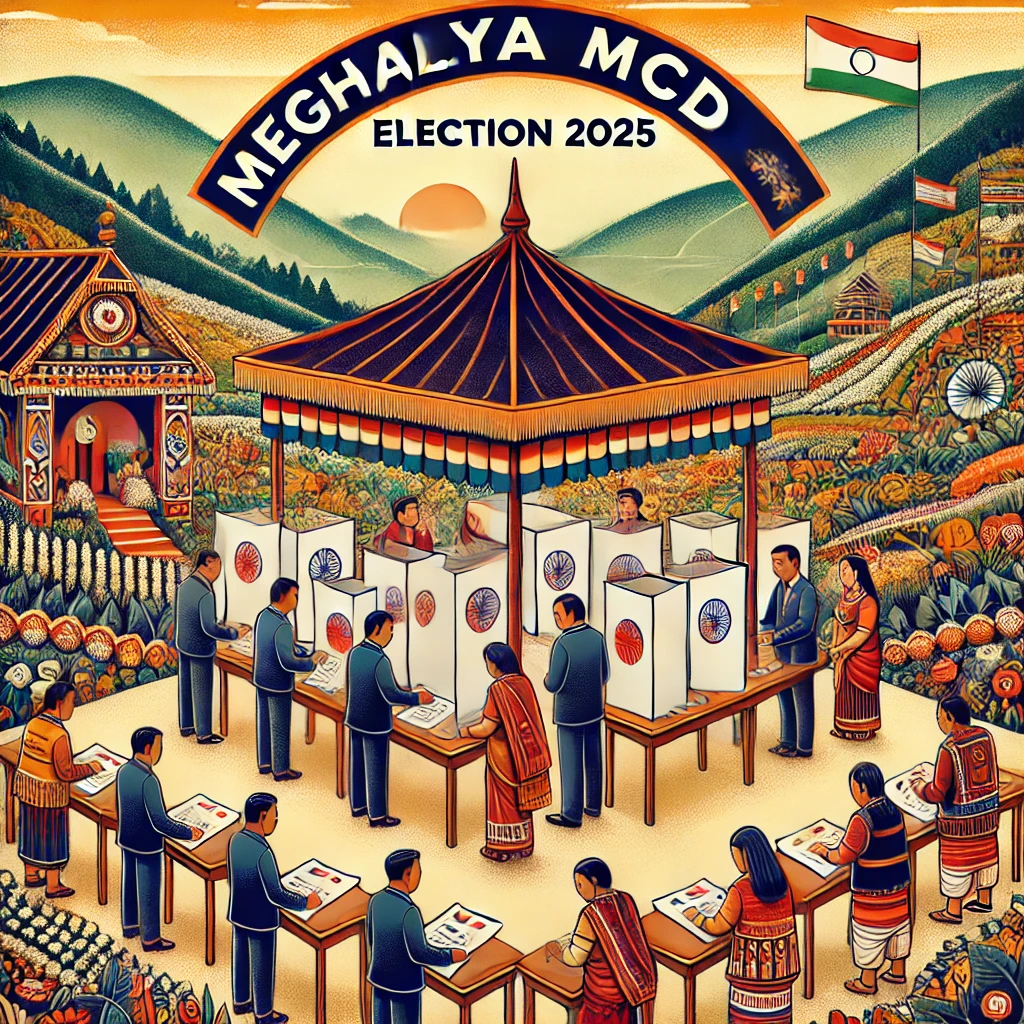Introduction
The Meghalaya Municipal Corporation Election 2025 is a crucial event shaping the urban governance of the state. While Meghalaya has historically relied more on Autonomous District Councils (ADCs) due to its unique socio-political framework, the push for a more structured urban local governance through the Municipal Corporation Elections (MCD) is significant. This blog explores the electoral process, constitutional provisions, and the potential impact of these elections on Meghalaya’s governance structure.
Understanding the Meghalaya MCD Election 2025
Historical Context of Urban Local Governance in Meghalaya
Meghalaya, unlike other Indian states, has a distinct governance structure due to its Sixth Schedule provisions. The Sixth Schedule of the Indian Constitution grants special autonomy to tribal regions, leading to the establishment of ADCs. However, urban areas require structured governance, and this is where municipal corporations play a pivotal role.
With the upcoming 2025 elections, there is a growing discourse on balancing the autonomy of ADCs with the need for urban development and efficient municipal governance. The implementation of Municipal Corporation elections aims to streamline urban administration, bringing Meghalaya’s cities in line with modern urban governance frameworks.
Constitutional Provisions Governing Municipal Elections in India
Municipal elections in India are governed by the 74th Constitutional Amendment Act of 1992, which added Part IXA to the Indian Constitution. The following constitutional provisions are relevant:
1. Article 243P – Definitions
This article defines terms related to municipal governance, including Nagar Panchayats, Municipal Councils, and Municipal Corporations.
2. Article 243Q – Constitution of Municipalities
States must establish three types of municipalities based on population size:
- Nagar Panchayat (for transitional areas)
- Municipal Council (for smaller urban areas)
- Municipal Corporation (for larger urban areas)
Given Meghalaya’s unique tribal governance, the extension of Municipal Corporations has been a subject of debate.
3. Article 243R – Composition of Municipalities
Municipalities must consist of elected representatives and may include nominated members with expertise in municipal administration.
4. Article 243S – Constitution of Wards Committees
For cities with a large population, Wards Committees must be formed to ensure local governance at the micro level.
5. Article 243T – Reservation of Seats
Seats in every municipality must be reserved for:
- Scheduled Castes (SCs) and Scheduled Tribes (STs)
- Women (one-third of total seats)
Given Meghalaya’s predominantly tribal population, ST reservations play a crucial role in its municipal governance.
6. Article 243U – Term of Municipalities
Municipal bodies have a five-year tenure. Elections must be conducted before the term expires.
7. Article 243V – Disqualifications for Membership
Criteria for disqualifying a candidate from contesting municipal elections include insolvency, criminal records, and mental instability.
8. Article 243W – Powers, Authority, and Responsibilities of Municipalities
Municipalities handle urban planning, economic development, infrastructure, sanitation, public health, and taxation.
9. Article 243X – Financial Powers
Municipalities can impose taxes, fees, and tolls to generate revenue.
10. Article 243Z – Audit and Accounts
Municipalities must maintain transparent financial records audited by the state.
Gandhian Principles: The Timeless Ideals for a Better Society
Meghalaya’s Unique Challenge: Autonomous District Councils vs. MCDs
Unlike other states, Meghalaya has ADCs that govern local matters under the Sixth Schedule. This raises questions about the relevance and necessity of MCDs. Some key challenges include:
- Resistance from Traditional Institutions – Tribal councils and ADCs fear losing their autonomy.
- Legal Complexities – Harmonizing Sixth Schedule provisions with the 74th Amendment.
- Public Awareness and Participation – Citizens need clarity on how MCDs will impact governance.
- Infrastructure and Administration – Implementing urban policies efficiently.
The 2025 election will be a litmus test for balancing constitutional mandates with local traditions.
Significance of the Meghalaya MCD Elections 2025
1. Strengthening Urban Governance
MCDs provide structured governance, ensuring better service delivery, waste management, and urban planning.
2. Improved Infrastructure Development
With a municipal corporation, Meghalaya’s urban areas can access more funds for roads, sewage systems, and housing.
3. Enhanced Civic Participation
Local elections empower citizens by giving them a direct say in governance.
4. Economic Development and Employment
A well-structured urban governance system attracts investment, boosting employment and economic growth.
5. Integration of State and Local Policies
Municipal corporations ensure that state policies align with urban needs, leading to holistic development.
Key Players and Political Dynamics in Meghalaya MCD Election 2025
Several political parties are expected to participate, including:
- National People’s Party (NPP) – The ruling party in Meghalaya, likely to push for MCD expansion.
- Indian National Congress (INC) – Historically influential, advocating for local governance reforms.
- Voice of the People Party (VPP) – A new entrant advocating for transparent governance.
- Bharatiya Janata Party (BJP) – Aiming to strengthen municipal governance in Northeast India.
Useful Link :
- Reference Election Commission of India
Public sentiment remains divided, with some favoring MCDs for urban development, while others support ADCs for cultural autonomy.
Challenges and Road Ahead
1. Ensuring Free and Fair Elections
A transparent electoral process is essential to gaining public trust.
2. Balancing Traditional and Modern Governance
Integrating municipal governance while respecting tribal autonomy is crucial.
3. Financial Sustainability
Municipalities must generate revenue through taxes and grants to function effectively.
4. Enhancing Public Awareness
Educational campaigns on MCDs’ benefits will improve voter participation.
Conclusion
The Meghalaya MCD Election 2025 is more than just a municipal poll; it is a turning point for urban governance in the state. While the constitutional provisions of the 74th Amendment lay a strong foundation, Meghalaya’s unique governance structure poses challenges in implementation. If executed effectively, MCDs can bring structured development while respecting the state’s rich tribal heritage.
As Meghalaya moves towards a new phase in governance, the upcoming elections will be closely watched, setting a precedent for urban governance in tribal-majority states. Voter participation, informed decision-making, and a transparent electoral process will determine the success of this transition.
For more updates on Meghalaya MCD Election 2025 and competitive exam preparation, stay connected with Chandra Classes—your trusted guide for UPSC, SSC, and State PCS examinations.

